Financial Management Report: WACC, Investment and Bankruptcy Analysis
VerifiedAdded on 2021/02/19
|14
|3724
|29
Report
AI Summary
This report delves into the core principles of financial management, providing a detailed analysis of cost of capital, investment appraisal techniques, and their implications on business decisions. The report begins with the calculation of book and market values for equities and debts, determining growth rates using dividend data. It then proceeds to calculate the Weighted Average Cost of Capital (WACC) using both book and market values, followed by a recalculation based on revised data. A critical discussion on integrating capital structure changes is presented, evaluating the potential cost savings and market value impacts. Furthermore, the report critically evaluates the effects of short-termism on bankruptcy and agency problems, using real-world examples to illustrate the consequences of prioritizing short-term gains. The report also covers various investment appraisal techniques, including the payback period, accounting rate of return (ARR), and net present value (NPV), offering detailed calculations and analysis for each technique. The ARR calculation includes a depreciation analysis to determine the return on investment, while the NPV analysis provides a framework for determining the project's viability. The report concludes by summarizing the key findings and implications of financial management practices on a company's financial health and strategic decision-making process.
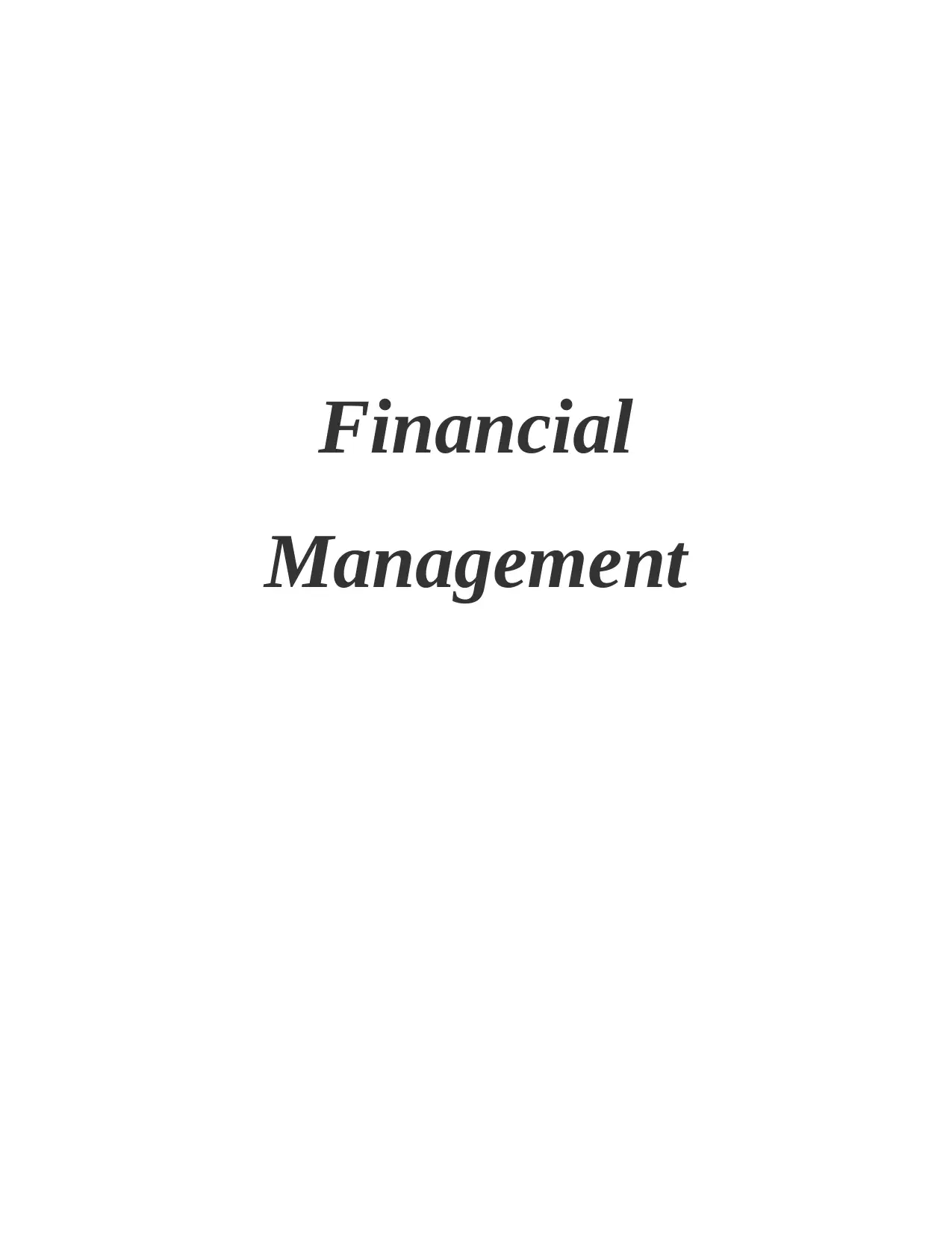
Financial
Management
Management
Paraphrase This Document
Need a fresh take? Get an instant paraphrase of this document with our AI Paraphraser
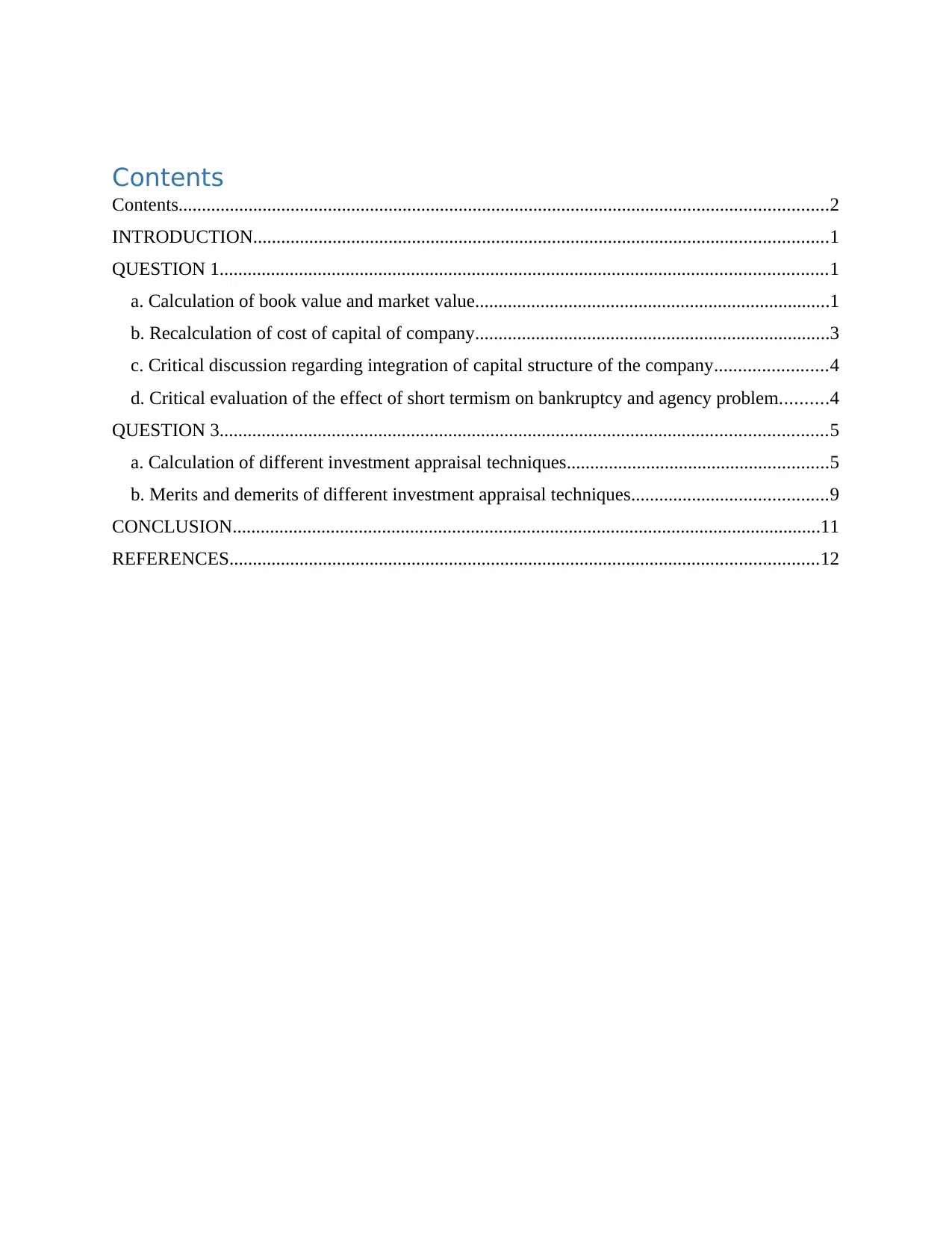
Contents
Contents...........................................................................................................................................2
INTRODUCTION...........................................................................................................................1
QUESTION 1..................................................................................................................................1
a. Calculation of book value and market value............................................................................1
b. Recalculation of cost of capital of company............................................................................3
c. Critical discussion regarding integration of capital structure of the company........................4
d. Critical evaluation of the effect of short termism on bankruptcy and agency problem..........4
QUESTION 3..................................................................................................................................5
a. Calculation of different investment appraisal techniques........................................................5
b. Merits and demerits of different investment appraisal techniques..........................................9
CONCLUSION..............................................................................................................................11
REFERENCES..............................................................................................................................12
Contents...........................................................................................................................................2
INTRODUCTION...........................................................................................................................1
QUESTION 1..................................................................................................................................1
a. Calculation of book value and market value............................................................................1
b. Recalculation of cost of capital of company............................................................................3
c. Critical discussion regarding integration of capital structure of the company........................4
d. Critical evaluation of the effect of short termism on bankruptcy and agency problem..........4
QUESTION 3..................................................................................................................................5
a. Calculation of different investment appraisal techniques........................................................5
b. Merits and demerits of different investment appraisal techniques..........................................9
CONCLUSION..............................................................................................................................11
REFERENCES..............................................................................................................................12
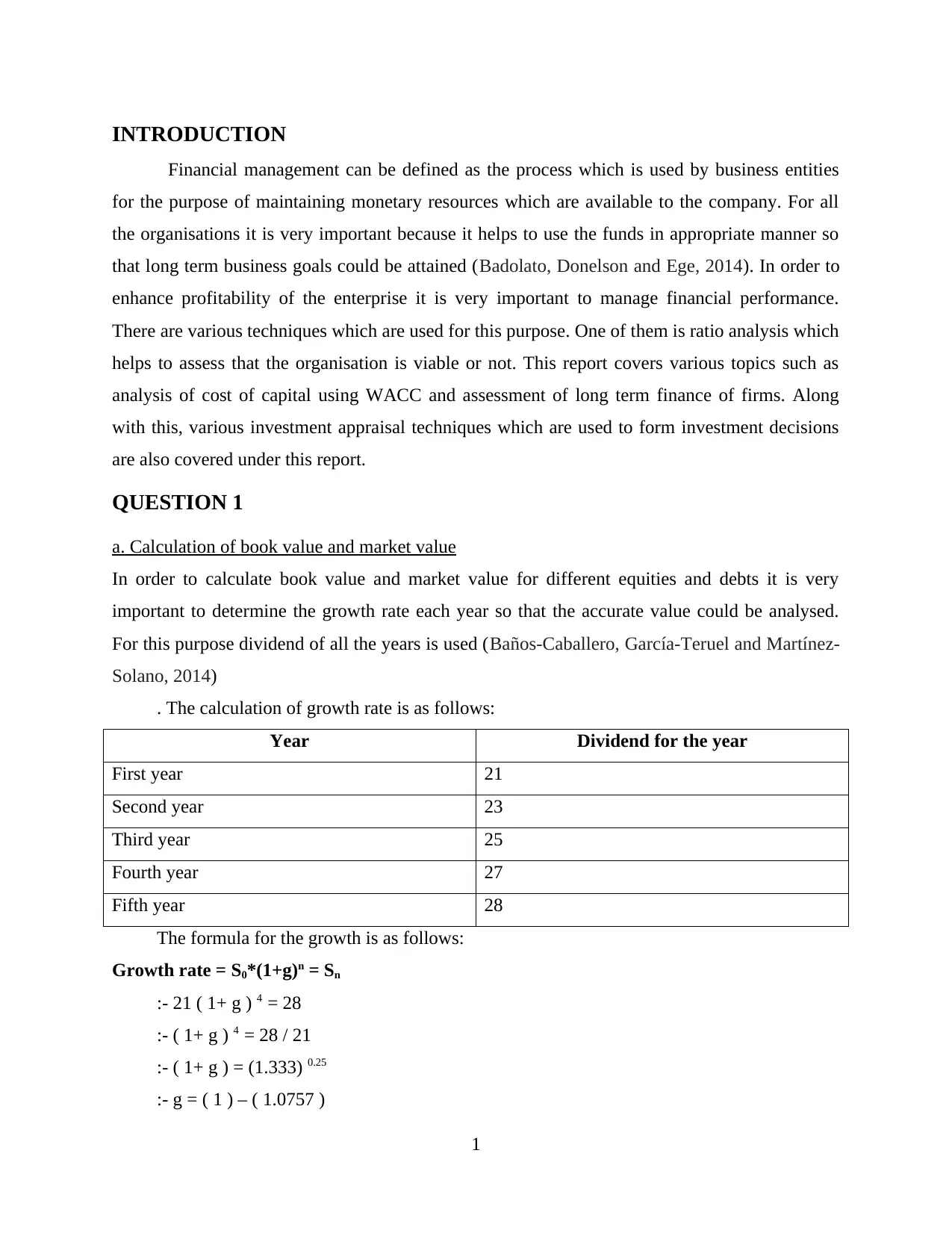
INTRODUCTION
Financial management can be defined as the process which is used by business entities
for the purpose of maintaining monetary resources which are available to the company. For all
the organisations it is very important because it helps to use the funds in appropriate manner so
that long term business goals could be attained (Badolato, Donelson and Ege, 2014). In order to
enhance profitability of the enterprise it is very important to manage financial performance.
There are various techniques which are used for this purpose. One of them is ratio analysis which
helps to assess that the organisation is viable or not. This report covers various topics such as
analysis of cost of capital using WACC and assessment of long term finance of firms. Along
with this, various investment appraisal techniques which are used to form investment decisions
are also covered under this report.
QUESTION 1
a. Calculation of book value and market value
In order to calculate book value and market value for different equities and debts it is very
important to determine the growth rate each year so that the accurate value could be analysed.
For this purpose dividend of all the years is used (Baños-Caballero, García-Teruel and Martínez-
Solano, 2014)
. The calculation of growth rate is as follows:
Year Dividend for the year
First year 21
Second year 23
Third year 25
Fourth year 27
Fifth year 28
The formula for the growth is as follows:
Growth rate = S0*(1+g)n = Sn
:- 21 ( 1+ g ) 4 = 28
:- ( 1+ g ) 4 = 28 / 21
:- ( 1+ g ) = (1.333) 0.25
:- g = ( 1 ) – ( 1.0757 )
1
Financial management can be defined as the process which is used by business entities
for the purpose of maintaining monetary resources which are available to the company. For all
the organisations it is very important because it helps to use the funds in appropriate manner so
that long term business goals could be attained (Badolato, Donelson and Ege, 2014). In order to
enhance profitability of the enterprise it is very important to manage financial performance.
There are various techniques which are used for this purpose. One of them is ratio analysis which
helps to assess that the organisation is viable or not. This report covers various topics such as
analysis of cost of capital using WACC and assessment of long term finance of firms. Along
with this, various investment appraisal techniques which are used to form investment decisions
are also covered under this report.
QUESTION 1
a. Calculation of book value and market value
In order to calculate book value and market value for different equities and debts it is very
important to determine the growth rate each year so that the accurate value could be analysed.
For this purpose dividend of all the years is used (Baños-Caballero, García-Teruel and Martínez-
Solano, 2014)
. The calculation of growth rate is as follows:
Year Dividend for the year
First year 21
Second year 23
Third year 25
Fourth year 27
Fifth year 28
The formula for the growth is as follows:
Growth rate = S0*(1+g)n = Sn
:- 21 ( 1+ g ) 4 = 28
:- ( 1+ g ) 4 = 28 / 21
:- ( 1+ g ) = (1.333) 0.25
:- g = ( 1 ) – ( 1.0757 )
1
⊘ This is a preview!⊘
Do you want full access?
Subscribe today to unlock all pages.

Trusted by 1+ million students worldwide
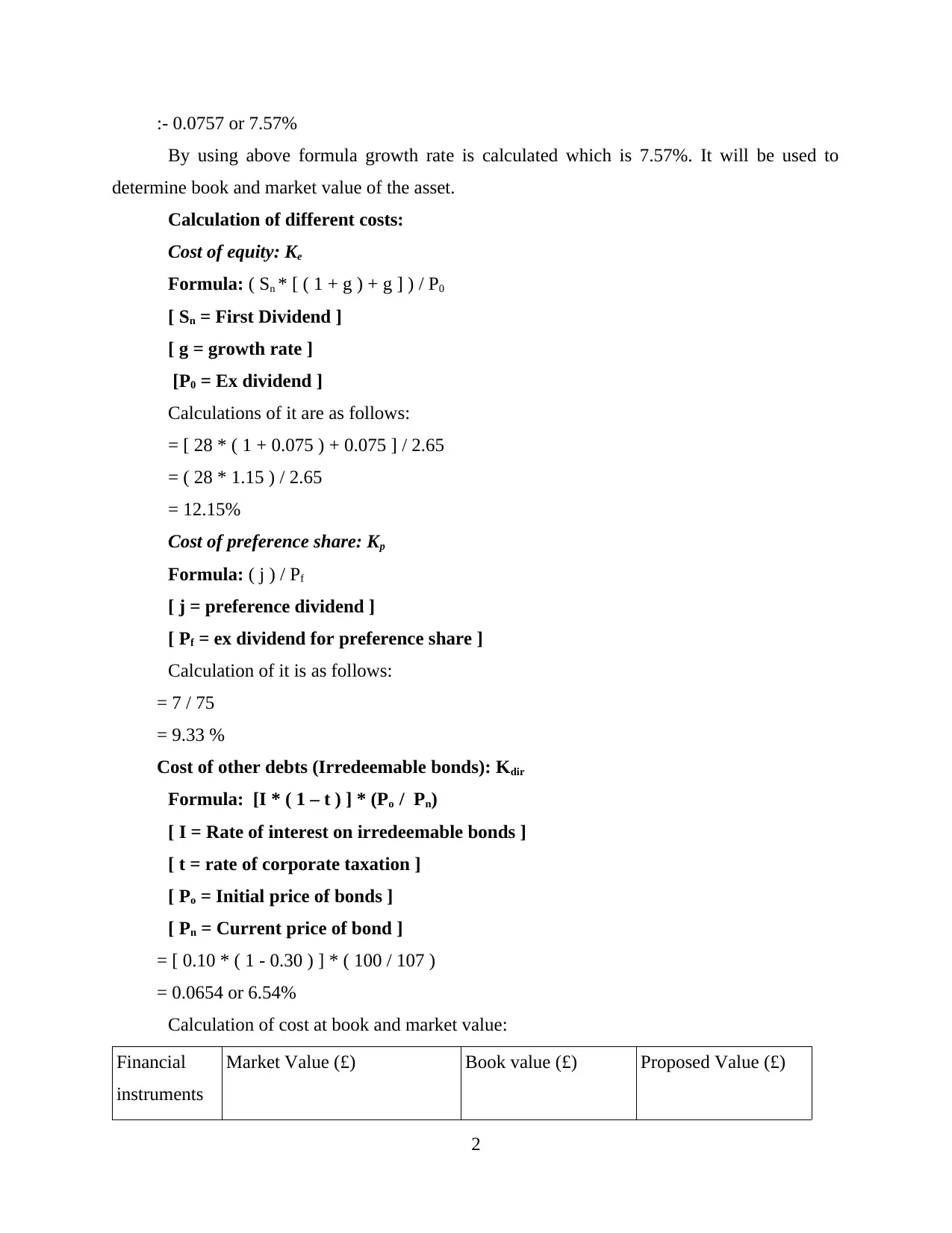
:- 0.0757 or 7.57%
By using above formula growth rate is calculated which is 7.57%. It will be used to
determine book and market value of the asset.
Calculation of different costs:
Cost of equity: Ke
Formula: ( Sn * [ ( 1 + g ) + g ] ) / P0
[ Sn = First Dividend ]
[ g = growth rate ]
[P0 = Ex dividend ]
Calculations of it are as follows:
= [ 28 * ( 1 + 0.075 ) + 0.075 ] / 2.65
= ( 28 * 1.15 ) / 2.65
= 12.15%
Cost of preference share: Kp
Formula: ( j ) / Pf
[ j = preference dividend ]
[ Pf = ex dividend for preference share ]
Calculation of it is as follows:
= 7 / 75
= 9.33 %
Cost of other debts (Irredeemable bonds): Kdir
Formula: [I * ( 1 – t ) ] * (Po / Pn)
[ I = Rate of interest on irredeemable bonds ]
[ t = rate of corporate taxation ]
[ Po = Initial price of bonds ]
[ Pn = Current price of bond ]
= [ 0.10 * ( 1 - 0.30 ) ] * ( 100 / 107 )
= 0.0654 or 6.54%
Calculation of cost at book and market value:
Financial
instruments
Market Value (£) Book value (£) Proposed Value (£)
2
By using above formula growth rate is calculated which is 7.57%. It will be used to
determine book and market value of the asset.
Calculation of different costs:
Cost of equity: Ke
Formula: ( Sn * [ ( 1 + g ) + g ] ) / P0
[ Sn = First Dividend ]
[ g = growth rate ]
[P0 = Ex dividend ]
Calculations of it are as follows:
= [ 28 * ( 1 + 0.075 ) + 0.075 ] / 2.65
= ( 28 * 1.15 ) / 2.65
= 12.15%
Cost of preference share: Kp
Formula: ( j ) / Pf
[ j = preference dividend ]
[ Pf = ex dividend for preference share ]
Calculation of it is as follows:
= 7 / 75
= 9.33 %
Cost of other debts (Irredeemable bonds): Kdir
Formula: [I * ( 1 – t ) ] * (Po / Pn)
[ I = Rate of interest on irredeemable bonds ]
[ t = rate of corporate taxation ]
[ Po = Initial price of bonds ]
[ Pn = Current price of bond ]
= [ 0.10 * ( 1 - 0.30 ) ] * ( 100 / 107 )
= 0.0654 or 6.54%
Calculation of cost at book and market value:
Financial
instruments
Market Value (£) Book value (£) Proposed Value (£)
2
Paraphrase This Document
Need a fresh take? Get an instant paraphrase of this document with our AI Paraphraser
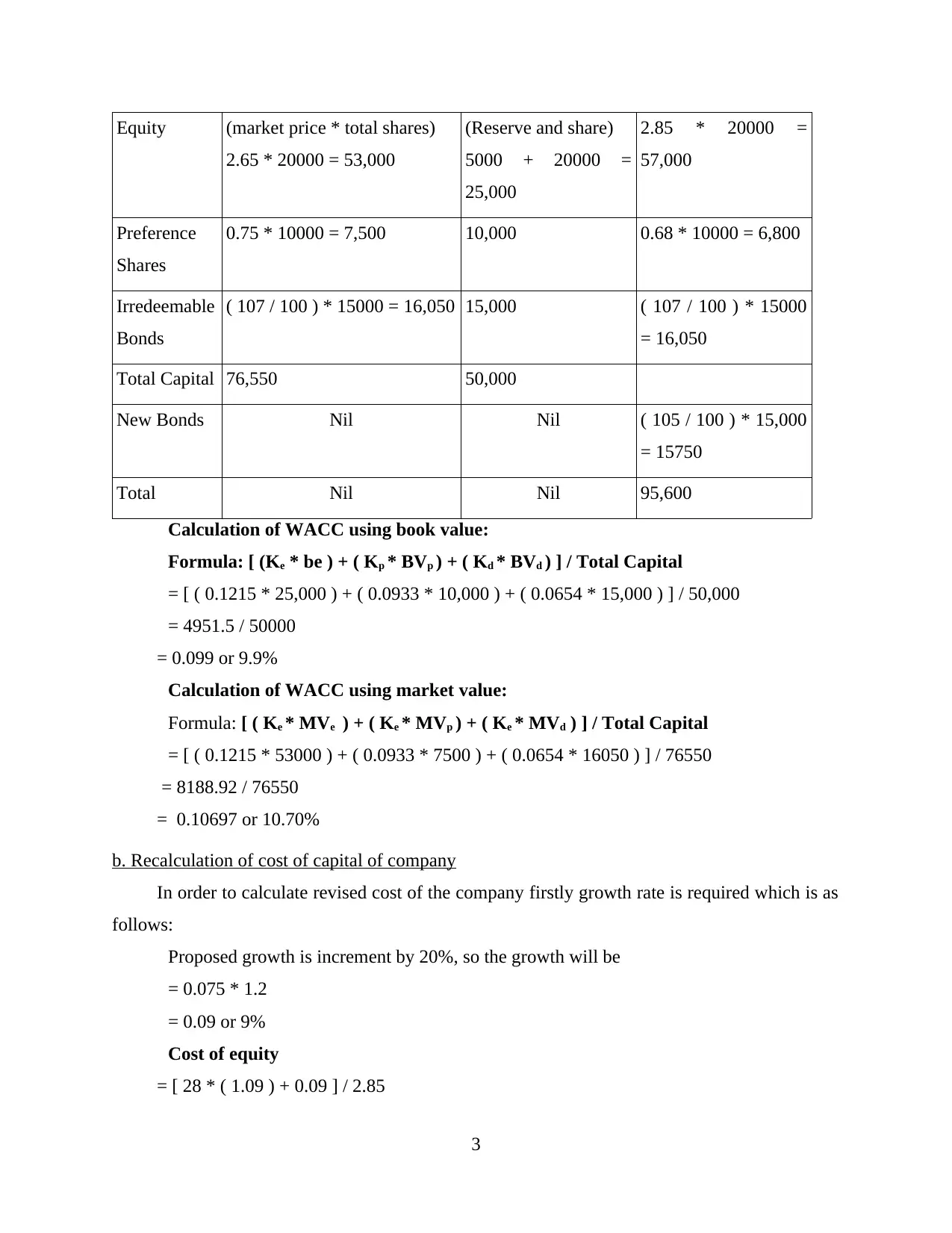
Equity (market price * total shares)
2.65 * 20000 = 53,000
(Reserve and share)
5000 + 20000 =
25,000
2.85 * 20000 =
57,000
Preference
Shares
0.75 * 10000 = 7,500 10,000 0.68 * 10000 = 6,800
Irredeemable
Bonds
( 107 / 100 ) * 15000 = 16,050 15,000 ( 107 / 100 ) * 15000
= 16,050
Total Capital 76,550 50,000
New Bonds Nil Nil ( 105 / 100 ) * 15,000
= 15750
Total Nil Nil 95,600
Calculation of WACC using book value:
Formula: [ (Ke * be ) + ( Kp * BVp ) + ( Kd * BVd ) ] / Total Capital
= [ ( 0.1215 * 25,000 ) + ( 0.0933 * 10,000 ) + ( 0.0654 * 15,000 ) ] / 50,000
= 4951.5 / 50000
= 0.099 or 9.9%
Calculation of WACC using market value:
Formula: [ ( Ke * MVe ) + ( Ke * MVp ) + ( Ke * MVd ) ] / Total Capital
= [ ( 0.1215 * 53000 ) + ( 0.0933 * 7500 ) + ( 0.0654 * 16050 ) ] / 76550
= 8188.92 / 76550
= 0.10697 or 10.70%
b. Recalculation of cost of capital of company
In order to calculate revised cost of the company firstly growth rate is required which is as
follows:
Proposed growth is increment by 20%, so the growth will be
= 0.075 * 1.2
= 0.09 or 9%
Cost of equity
= [ 28 * ( 1.09 ) + 0.09 ] / 2.85
3
2.65 * 20000 = 53,000
(Reserve and share)
5000 + 20000 =
25,000
2.85 * 20000 =
57,000
Preference
Shares
0.75 * 10000 = 7,500 10,000 0.68 * 10000 = 6,800
Irredeemable
Bonds
( 107 / 100 ) * 15000 = 16,050 15,000 ( 107 / 100 ) * 15000
= 16,050
Total Capital 76,550 50,000
New Bonds Nil Nil ( 105 / 100 ) * 15,000
= 15750
Total Nil Nil 95,600
Calculation of WACC using book value:
Formula: [ (Ke * be ) + ( Kp * BVp ) + ( Kd * BVd ) ] / Total Capital
= [ ( 0.1215 * 25,000 ) + ( 0.0933 * 10,000 ) + ( 0.0654 * 15,000 ) ] / 50,000
= 4951.5 / 50000
= 0.099 or 9.9%
Calculation of WACC using market value:
Formula: [ ( Ke * MVe ) + ( Ke * MVp ) + ( Ke * MVd ) ] / Total Capital
= [ ( 0.1215 * 53000 ) + ( 0.0933 * 7500 ) + ( 0.0654 * 16050 ) ] / 76550
= 8188.92 / 76550
= 0.10697 or 10.70%
b. Recalculation of cost of capital of company
In order to calculate revised cost of the company firstly growth rate is required which is as
follows:
Proposed growth is increment by 20%, so the growth will be
= 0.075 * 1.2
= 0.09 or 9%
Cost of equity
= [ 28 * ( 1.09 ) + 0.09 ] / 2.85
3

= 0.1074 or 10.74%
Cost of preference share
= [ ( 7 / 68 ) ]
= 0.1029 or 10.29%
Cost of irredeemable bonds
= [ 10 ( 1 - 0.30 ) ] * 100 / 107
= 0.0654 or 6.54%
Cost of new bonds
= [ 0.11 ( 1 - 0.30 ) ] * 100 / 105
= 0.0733 or 7.33%
Proposed WACC with revised data:
= [ (0.09 * 57,000 ) + ( 0.1074 * 6,800 ) + ( 0.0654 * 16,050 ) + ( 0.0733 * 15,750 ) /
95,600
= 8064.47 / 95600
= 0.0844 or 8.44%
c. Critical discussion regarding integration of capital structure of the company
If Kadlex Plc make investment in the new bonds then the revised cost of capital with WACC will
be around 8.44% and the market value if 10.44%. With the help of the new investment in bonds
organisation can reduce overall cost by 2.26% ( 10.70 – 8.44 ). If the changes in the capital
structure are made by the company then it will result in decrement in the cost by 2.26%. By
analysing the revised calculations it has been assessed that if proposed changes in capital
structure are made then it will help to save cost by 2.26% (Bryce, 2017).
d. Critical evaluation of the effect of short termism on bankruptcy and agency problem
Short termism can be defined as the process in which organisations focus on making
investments in short term investments so that current earnings could be maintained. While
investing in short term sources organisation reduced long term incomes or investments. There
will be huge impact of it on bankruptcy and agency problem. It could be understood with the
help of following example:
A financial executive advisor is being asked to make investment of 50 million in this
situation organisation have following three options in which investment could be recovered:
1. Receiving 5 million as returns in 1 year
4
Cost of preference share
= [ ( 7 / 68 ) ]
= 0.1029 or 10.29%
Cost of irredeemable bonds
= [ 10 ( 1 - 0.30 ) ] * 100 / 107
= 0.0654 or 6.54%
Cost of new bonds
= [ 0.11 ( 1 - 0.30 ) ] * 100 / 105
= 0.0733 or 7.33%
Proposed WACC with revised data:
= [ (0.09 * 57,000 ) + ( 0.1074 * 6,800 ) + ( 0.0654 * 16,050 ) + ( 0.0733 * 15,750 ) /
95,600
= 8064.47 / 95600
= 0.0844 or 8.44%
c. Critical discussion regarding integration of capital structure of the company
If Kadlex Plc make investment in the new bonds then the revised cost of capital with WACC will
be around 8.44% and the market value if 10.44%. With the help of the new investment in bonds
organisation can reduce overall cost by 2.26% ( 10.70 – 8.44 ). If the changes in the capital
structure are made by the company then it will result in decrement in the cost by 2.26%. By
analysing the revised calculations it has been assessed that if proposed changes in capital
structure are made then it will help to save cost by 2.26% (Bryce, 2017).
d. Critical evaluation of the effect of short termism on bankruptcy and agency problem
Short termism can be defined as the process in which organisations focus on making
investments in short term investments so that current earnings could be maintained. While
investing in short term sources organisation reduced long term incomes or investments. There
will be huge impact of it on bankruptcy and agency problem. It could be understood with the
help of following example:
A financial executive advisor is being asked to make investment of 50 million in this
situation organisation have following three options in which investment could be recovered:
1. Receiving 5 million as returns in 1 year
4
⊘ This is a preview!⊘
Do you want full access?
Subscribe today to unlock all pages.

Trusted by 1+ million students worldwide

2. Receiving 20 million as returns in 3 years
3. Receiving 25 million as returns in 5 years
From all the above options the financial advisor will select the option of receiving 5 million in
one year because it will result in money in hand in a small time period. Another viewpoint is that
their occupation and spot in the organisation are not secured so they select the option for self-
interest rather than organisation’s benefits. This type of situation implies to “Agency Problem” in
which interest of shareholders are ignored for making self-growth and development by
corporates. The impacts of this phenomena can be disastrous on a corporation's bankruptcy
(Burtonshaw-Gunn, 2017).
QUESTION 3
a. Calculation of different investment appraisal techniques
The pay back period: It is a technique which is used in capital budgeting for the purpose
of analysing that the amount which is invested in an asset will be recovered in how many years.
With the help of it long term investment decision are formulated by managers as it guides them
to invest monetary resources in that asset which may refund the funds as soon as possible. Main
objective of using this technique is to determine the time period in which investments could be
recovered by the organisation (Cornwall, Vang and Hartman, 2016). Formula of it is follows:
Pay back period = I / C
I = Initial investment
C = Cash Inflow
Calculation of it are as follows:
Information provided: Initial investment = 320000
Life of machine is 6 years
Cash inflow = 105000
Cash out flow = 15500
Net cash in flow = 105000 – 15500
= 89500
Pay back period = 320000 / 89500
= 3.58 years
5
3. Receiving 25 million as returns in 5 years
From all the above options the financial advisor will select the option of receiving 5 million in
one year because it will result in money in hand in a small time period. Another viewpoint is that
their occupation and spot in the organisation are not secured so they select the option for self-
interest rather than organisation’s benefits. This type of situation implies to “Agency Problem” in
which interest of shareholders are ignored for making self-growth and development by
corporates. The impacts of this phenomena can be disastrous on a corporation's bankruptcy
(Burtonshaw-Gunn, 2017).
QUESTION 3
a. Calculation of different investment appraisal techniques
The pay back period: It is a technique which is used in capital budgeting for the purpose
of analysing that the amount which is invested in an asset will be recovered in how many years.
With the help of it long term investment decision are formulated by managers as it guides them
to invest monetary resources in that asset which may refund the funds as soon as possible. Main
objective of using this technique is to determine the time period in which investments could be
recovered by the organisation (Cornwall, Vang and Hartman, 2016). Formula of it is follows:
Pay back period = I / C
I = Initial investment
C = Cash Inflow
Calculation of it are as follows:
Information provided: Initial investment = 320000
Life of machine is 6 years
Cash inflow = 105000
Cash out flow = 15500
Net cash in flow = 105000 – 15500
= 89500
Pay back period = 320000 / 89500
= 3.58 years
5
Paraphrase This Document
Need a fresh take? Get an instant paraphrase of this document with our AI Paraphraser

Analysis: From the above calculations it has been analysed that the amount which will be
invested in acquisition of new machine could be redeemed by Happy Meal Limited in 3.58 years.
It will be good for the organisation to buy it as it will repay the amount in half of the life of it.
The accounting rate of return: This technique of investment appraisal is also known as
average rate of return. With the help of it, that rate of return could be calculated which is being
generated from net profits of the investments (Dunham-Taylor and Pinczuk, 2014). While
calculating it time value of money is ignored as it do not take it in to account. Formula of it is as
follows:
Accounting rate of return = Average net income after interest and tax / Initial
investment *100
Calculation of ARR is as follows:
Years
Particulars First Second Third Forth Fifth Sixth
Cash Inflow 105000 105000 105000 105000 105000 105000
Less: Cash outflow 15500 15500 15500 15500 15500 15500
Net Cash Inflow 89500 89500 89500 89500 89500 89500
Less: Dep. At 20% per
annum
57600 46080 36864 29491.20 23592.96 18874.37
Cash inflow after dep. 31900 43420 52636 60008.80 65907.04 70625.63
Average cash inflow= Total cash inflow / Life of asset
= 324498 / 6
= 31900 + 43420 + 52636 + 60008.80 + 65907.04 + 70625.63 / 6
= 54083
ARR = 54083 /320000 *100
= 16.90%
Analysis: From the above calculation of ARR it has been analysed that if the machine is
purchased by Happy Meal Limited then it will provide returns at the rate of 16.90% on yearly
basis. It will be a beneficial investment for the organisation because with the help of it higher
returns could be generated by the company (Finkler, Smith and Calabrese, 2018).
Working notes:
6
invested in acquisition of new machine could be redeemed by Happy Meal Limited in 3.58 years.
It will be good for the organisation to buy it as it will repay the amount in half of the life of it.
The accounting rate of return: This technique of investment appraisal is also known as
average rate of return. With the help of it, that rate of return could be calculated which is being
generated from net profits of the investments (Dunham-Taylor and Pinczuk, 2014). While
calculating it time value of money is ignored as it do not take it in to account. Formula of it is as
follows:
Accounting rate of return = Average net income after interest and tax / Initial
investment *100
Calculation of ARR is as follows:
Years
Particulars First Second Third Forth Fifth Sixth
Cash Inflow 105000 105000 105000 105000 105000 105000
Less: Cash outflow 15500 15500 15500 15500 15500 15500
Net Cash Inflow 89500 89500 89500 89500 89500 89500
Less: Dep. At 20% per
annum
57600 46080 36864 29491.20 23592.96 18874.37
Cash inflow after dep. 31900 43420 52636 60008.80 65907.04 70625.63
Average cash inflow= Total cash inflow / Life of asset
= 324498 / 6
= 31900 + 43420 + 52636 + 60008.80 + 65907.04 + 70625.63 / 6
= 54083
ARR = 54083 /320000 *100
= 16.90%
Analysis: From the above calculation of ARR it has been analysed that if the machine is
purchased by Happy Meal Limited then it will provide returns at the rate of 16.90% on yearly
basis. It will be a beneficial investment for the organisation because with the help of it higher
returns could be generated by the company (Finkler, Smith and Calabrese, 2018).
Working notes:
6
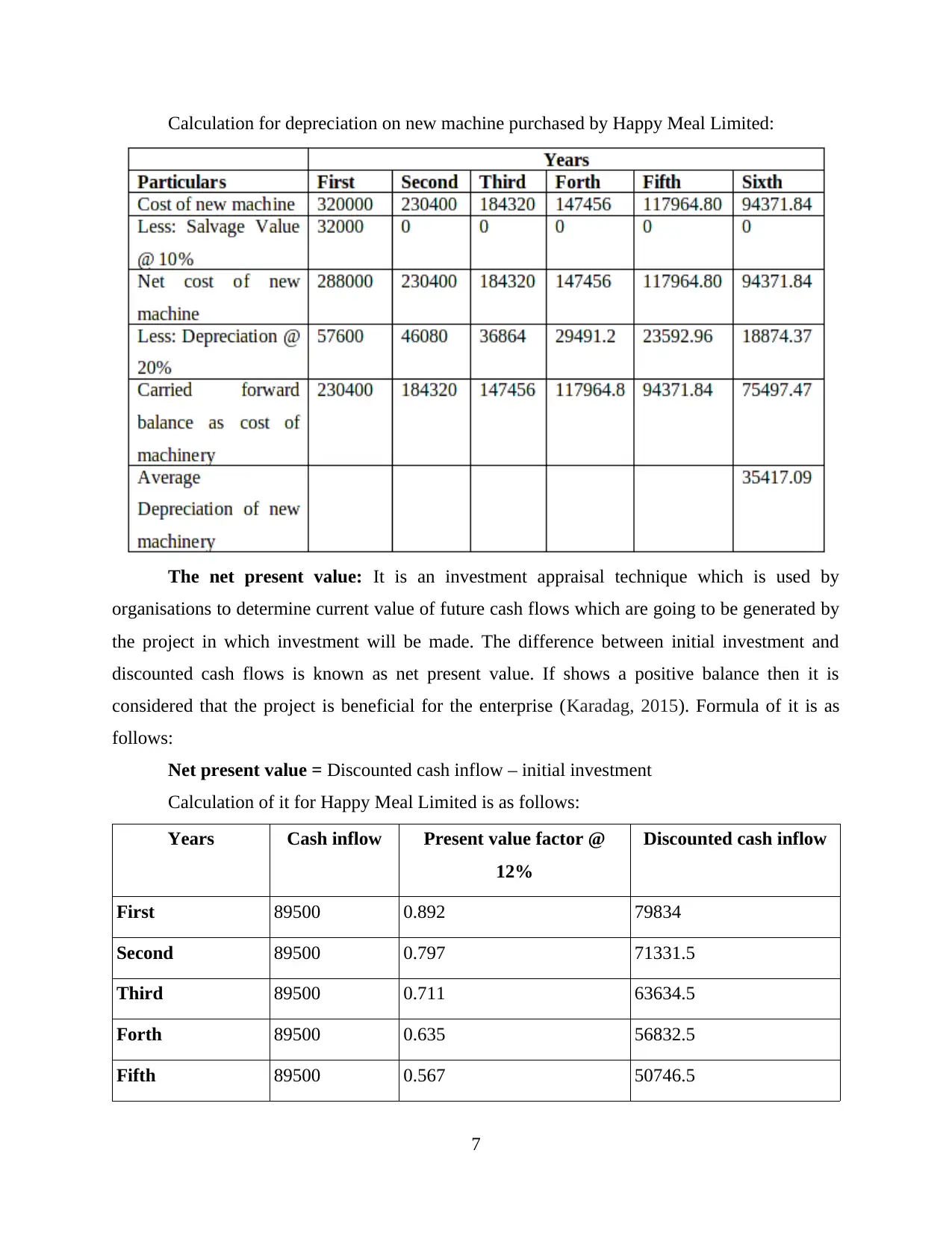
Calculation for depreciation on new machine purchased by Happy Meal Limited:
The net present value: It is an investment appraisal technique which is used by
organisations to determine current value of future cash flows which are going to be generated by
the project in which investment will be made. The difference between initial investment and
discounted cash flows is known as net present value. If shows a positive balance then it is
considered that the project is beneficial for the enterprise (Karadag, 2015). Formula of it is as
follows:
Net present value = Discounted cash inflow – initial investment
Calculation of it for Happy Meal Limited is as follows:
Years Cash inflow Present value factor @
12%
Discounted cash inflow
First 89500 0.892 79834
Second 89500 0.797 71331.5
Third 89500 0.711 63634.5
Forth 89500 0.635 56832.5
Fifth 89500 0.567 50746.5
7
The net present value: It is an investment appraisal technique which is used by
organisations to determine current value of future cash flows which are going to be generated by
the project in which investment will be made. The difference between initial investment and
discounted cash flows is known as net present value. If shows a positive balance then it is
considered that the project is beneficial for the enterprise (Karadag, 2015). Formula of it is as
follows:
Net present value = Discounted cash inflow – initial investment
Calculation of it for Happy Meal Limited is as follows:
Years Cash inflow Present value factor @
12%
Discounted cash inflow
First 89500 0.892 79834
Second 89500 0.797 71331.5
Third 89500 0.711 63634.5
Forth 89500 0.635 56832.5
Fifth 89500 0.567 50746.5
7
⊘ This is a preview!⊘
Do you want full access?
Subscribe today to unlock all pages.

Trusted by 1+ million students worldwide
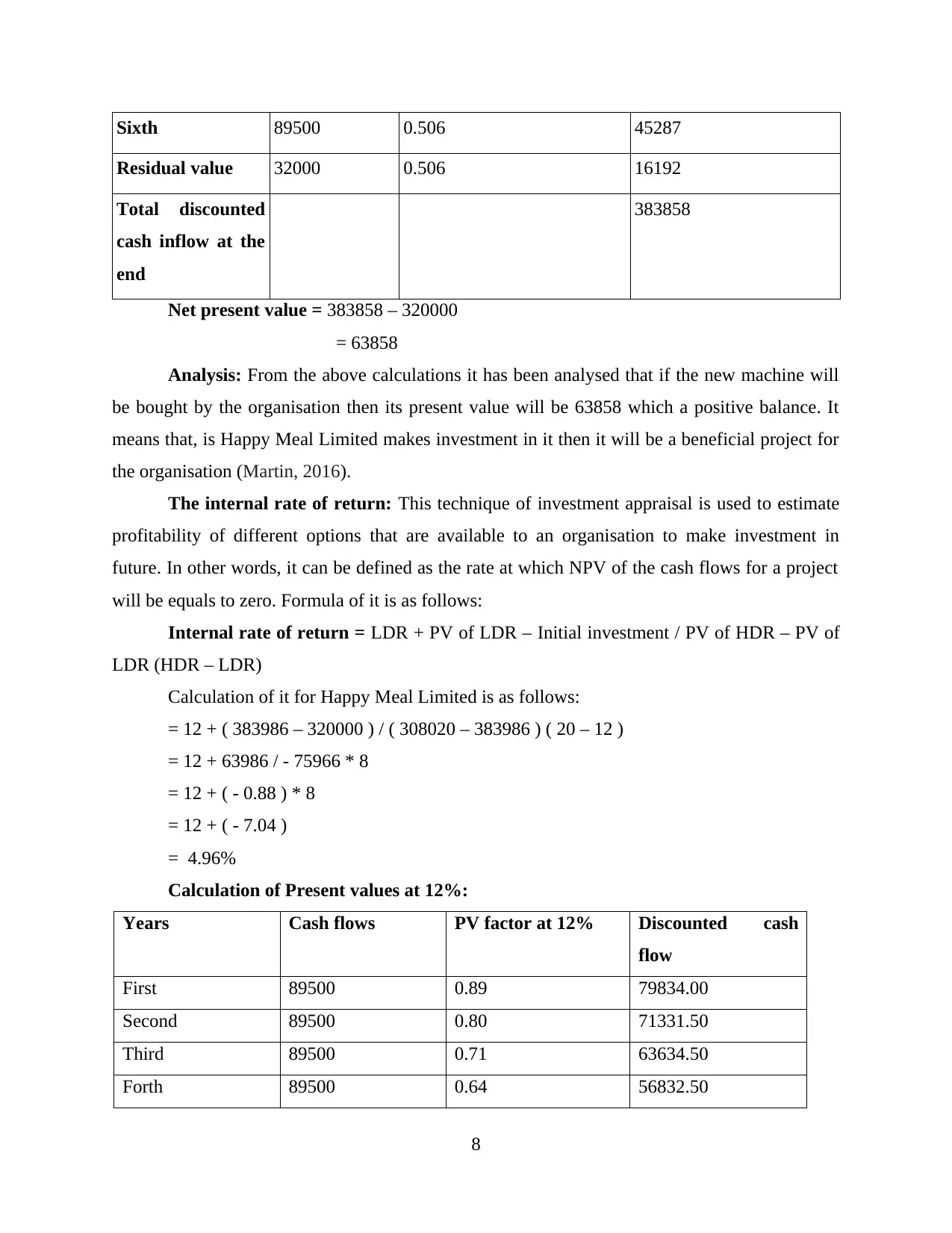
Sixth 89500 0.506 45287
Residual value 32000 0.506 16192
Total discounted
cash inflow at the
end
383858
Net present value = 383858 – 320000
= 63858
Analysis: From the above calculations it has been analysed that if the new machine will
be bought by the organisation then its present value will be 63858 which a positive balance. It
means that, is Happy Meal Limited makes investment in it then it will be a beneficial project for
the organisation (Martin, 2016).
The internal rate of return: This technique of investment appraisal is used to estimate
profitability of different options that are available to an organisation to make investment in
future. In other words, it can be defined as the rate at which NPV of the cash flows for a project
will be equals to zero. Formula of it is as follows:
Internal rate of return = LDR + PV of LDR – Initial investment / PV of HDR – PV of
LDR (HDR – LDR)
Calculation of it for Happy Meal Limited is as follows:
= 12 + ( 383986 – 320000 ) / ( 308020 – 383986 ) ( 20 – 12 )
= 12 + 63986 / - 75966 * 8
= 12 + ( - 0.88 ) * 8
= 12 + ( - 7.04 )
= 4.96%
Calculation of Present values at 12%:
Years Cash flows PV factor at 12% Discounted cash
flow
First 89500 0.89 79834.00
Second 89500 0.80 71331.50
Third 89500 0.71 63634.50
Forth 89500 0.64 56832.50
8
Residual value 32000 0.506 16192
Total discounted
cash inflow at the
end
383858
Net present value = 383858 – 320000
= 63858
Analysis: From the above calculations it has been analysed that if the new machine will
be bought by the organisation then its present value will be 63858 which a positive balance. It
means that, is Happy Meal Limited makes investment in it then it will be a beneficial project for
the organisation (Martin, 2016).
The internal rate of return: This technique of investment appraisal is used to estimate
profitability of different options that are available to an organisation to make investment in
future. In other words, it can be defined as the rate at which NPV of the cash flows for a project
will be equals to zero. Formula of it is as follows:
Internal rate of return = LDR + PV of LDR – Initial investment / PV of HDR – PV of
LDR (HDR – LDR)
Calculation of it for Happy Meal Limited is as follows:
= 12 + ( 383986 – 320000 ) / ( 308020 – 383986 ) ( 20 – 12 )
= 12 + 63986 / - 75966 * 8
= 12 + ( - 0.88 ) * 8
= 12 + ( - 7.04 )
= 4.96%
Calculation of Present values at 12%:
Years Cash flows PV factor at 12% Discounted cash
flow
First 89500 0.89 79834.00
Second 89500 0.80 71331.50
Third 89500 0.71 63634.50
Forth 89500 0.64 56832.50
8
Paraphrase This Document
Need a fresh take? Get an instant paraphrase of this document with our AI Paraphraser
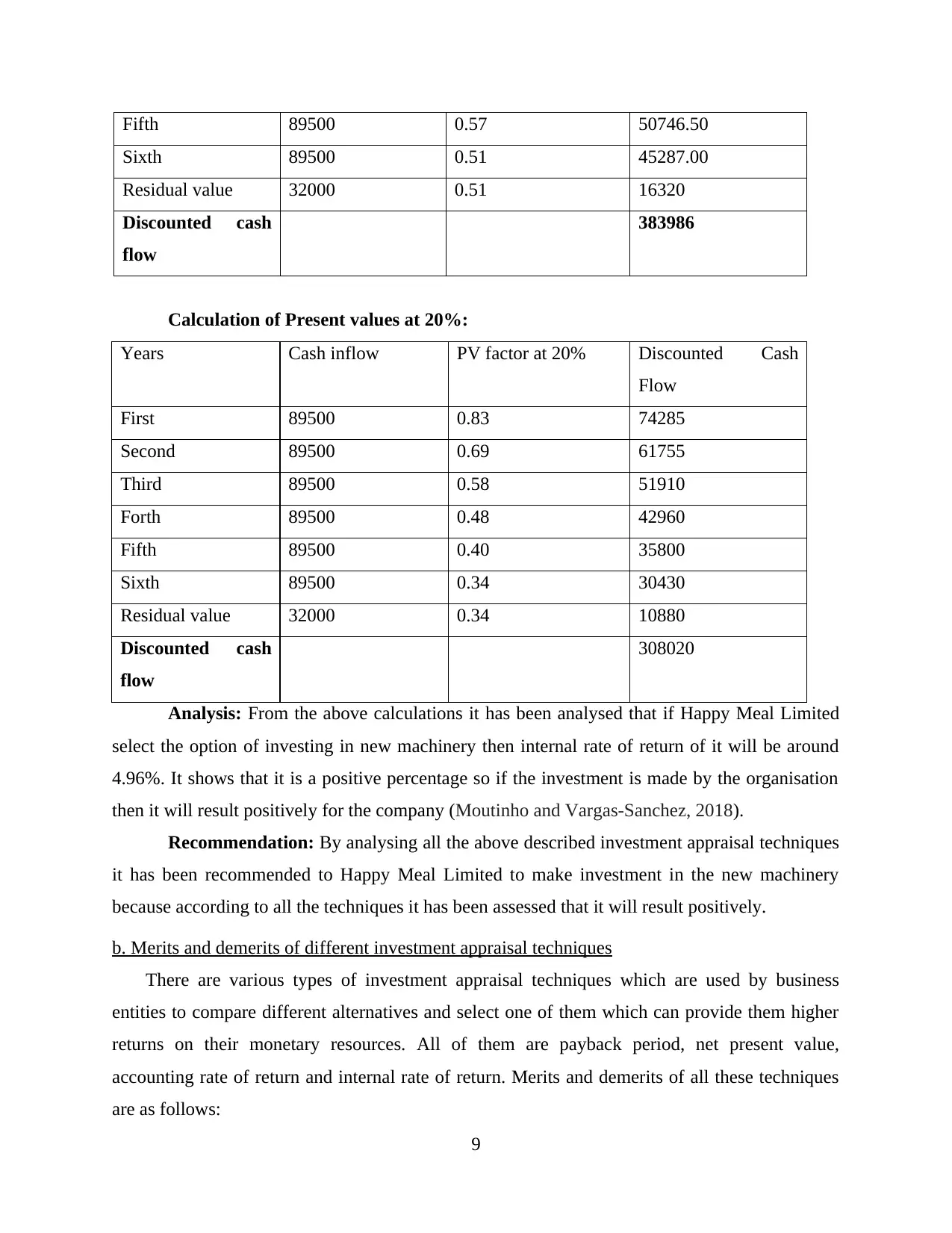
Fifth 89500 0.57 50746.50
Sixth 89500 0.51 45287.00
Residual value 32000 0.51 16320
Discounted cash
flow
383986
Calculation of Present values at 20%:
Years Cash inflow PV factor at 20% Discounted Cash
Flow
First 89500 0.83 74285
Second 89500 0.69 61755
Third 89500 0.58 51910
Forth 89500 0.48 42960
Fifth 89500 0.40 35800
Sixth 89500 0.34 30430
Residual value 32000 0.34 10880
Discounted cash
flow
308020
Analysis: From the above calculations it has been analysed that if Happy Meal Limited
select the option of investing in new machinery then internal rate of return of it will be around
4.96%. It shows that it is a positive percentage so if the investment is made by the organisation
then it will result positively for the company (Moutinho and Vargas-Sanchez, 2018).
Recommendation: By analysing all the above described investment appraisal techniques
it has been recommended to Happy Meal Limited to make investment in the new machinery
because according to all the techniques it has been assessed that it will result positively.
b. Merits and demerits of different investment appraisal techniques
There are various types of investment appraisal techniques which are used by business
entities to compare different alternatives and select one of them which can provide them higher
returns on their monetary resources. All of them are payback period, net present value,
accounting rate of return and internal rate of return. Merits and demerits of all these techniques
are as follows:
9
Sixth 89500 0.51 45287.00
Residual value 32000 0.51 16320
Discounted cash
flow
383986
Calculation of Present values at 20%:
Years Cash inflow PV factor at 20% Discounted Cash
Flow
First 89500 0.83 74285
Second 89500 0.69 61755
Third 89500 0.58 51910
Forth 89500 0.48 42960
Fifth 89500 0.40 35800
Sixth 89500 0.34 30430
Residual value 32000 0.34 10880
Discounted cash
flow
308020
Analysis: From the above calculations it has been analysed that if Happy Meal Limited
select the option of investing in new machinery then internal rate of return of it will be around
4.96%. It shows that it is a positive percentage so if the investment is made by the organisation
then it will result positively for the company (Moutinho and Vargas-Sanchez, 2018).
Recommendation: By analysing all the above described investment appraisal techniques
it has been recommended to Happy Meal Limited to make investment in the new machinery
because according to all the techniques it has been assessed that it will result positively.
b. Merits and demerits of different investment appraisal techniques
There are various types of investment appraisal techniques which are used by business
entities to compare different alternatives and select one of them which can provide them higher
returns on their monetary resources. All of them are payback period, net present value,
accounting rate of return and internal rate of return. Merits and demerits of all these techniques
are as follows:
9
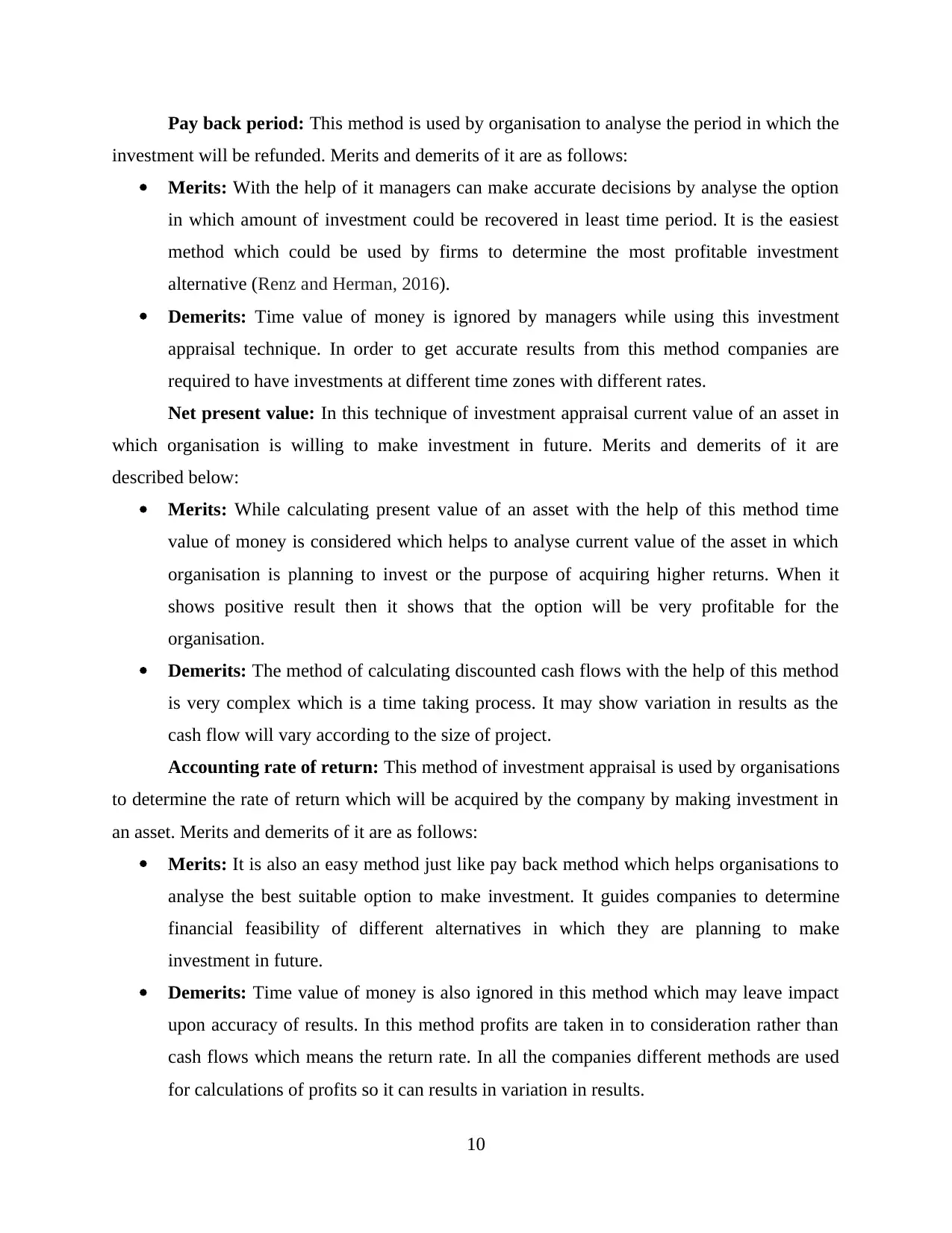
Pay back period: This method is used by organisation to analyse the period in which the
investment will be refunded. Merits and demerits of it are as follows:
Merits: With the help of it managers can make accurate decisions by analyse the option
in which amount of investment could be recovered in least time period. It is the easiest
method which could be used by firms to determine the most profitable investment
alternative (Renz and Herman, 2016).
Demerits: Time value of money is ignored by managers while using this investment
appraisal technique. In order to get accurate results from this method companies are
required to have investments at different time zones with different rates.
Net present value: In this technique of investment appraisal current value of an asset in
which organisation is willing to make investment in future. Merits and demerits of it are
described below:
Merits: While calculating present value of an asset with the help of this method time
value of money is considered which helps to analyse current value of the asset in which
organisation is planning to invest or the purpose of acquiring higher returns. When it
shows positive result then it shows that the option will be very profitable for the
organisation.
Demerits: The method of calculating discounted cash flows with the help of this method
is very complex which is a time taking process. It may show variation in results as the
cash flow will vary according to the size of project.
Accounting rate of return: This method of investment appraisal is used by organisations
to determine the rate of return which will be acquired by the company by making investment in
an asset. Merits and demerits of it are as follows:
Merits: It is also an easy method just like pay back method which helps organisations to
analyse the best suitable option to make investment. It guides companies to determine
financial feasibility of different alternatives in which they are planning to make
investment in future.
Demerits: Time value of money is also ignored in this method which may leave impact
upon accuracy of results. In this method profits are taken in to consideration rather than
cash flows which means the return rate. In all the companies different methods are used
for calculations of profits so it can results in variation in results.
10
investment will be refunded. Merits and demerits of it are as follows:
Merits: With the help of it managers can make accurate decisions by analyse the option
in which amount of investment could be recovered in least time period. It is the easiest
method which could be used by firms to determine the most profitable investment
alternative (Renz and Herman, 2016).
Demerits: Time value of money is ignored by managers while using this investment
appraisal technique. In order to get accurate results from this method companies are
required to have investments at different time zones with different rates.
Net present value: In this technique of investment appraisal current value of an asset in
which organisation is willing to make investment in future. Merits and demerits of it are
described below:
Merits: While calculating present value of an asset with the help of this method time
value of money is considered which helps to analyse current value of the asset in which
organisation is planning to invest or the purpose of acquiring higher returns. When it
shows positive result then it shows that the option will be very profitable for the
organisation.
Demerits: The method of calculating discounted cash flows with the help of this method
is very complex which is a time taking process. It may show variation in results as the
cash flow will vary according to the size of project.
Accounting rate of return: This method of investment appraisal is used by organisations
to determine the rate of return which will be acquired by the company by making investment in
an asset. Merits and demerits of it are as follows:
Merits: It is also an easy method just like pay back method which helps organisations to
analyse the best suitable option to make investment. It guides companies to determine
financial feasibility of different alternatives in which they are planning to make
investment in future.
Demerits: Time value of money is also ignored in this method which may leave impact
upon accuracy of results. In this method profits are taken in to consideration rather than
cash flows which means the return rate. In all the companies different methods are used
for calculations of profits so it can results in variation in results.
10
⊘ This is a preview!⊘
Do you want full access?
Subscribe today to unlock all pages.

Trusted by 1+ million students worldwide
1 out of 14
Related Documents
Your All-in-One AI-Powered Toolkit for Academic Success.
+13062052269
info@desklib.com
Available 24*7 on WhatsApp / Email
![[object Object]](/_next/static/media/star-bottom.7253800d.svg)
Unlock your academic potential
Copyright © 2020–2025 A2Z Services. All Rights Reserved. Developed and managed by ZUCOL.





